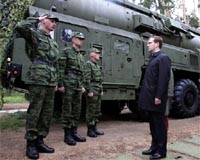| . |  |
. |
Moscow (UPI) Dec 28, 2009 Russia has successfully test-launched an intercontinental ballistic missile, opting to extend the lifespan of its Soviet-era nuclear arsenal. The 112-foot missile, capable of carrying 10 warheads, was fired from the Orenburg district on Russia's frontiers with Kazakhstan. It struck its target, 4,000 miles away, on the Kamchatka Peninsula in the Russian Far East, Russian news agencies reported. "Pre-launch operations, the launch and flight went strictly according to plan," a spokesman for Russia's Strategic Missile Forces, Col. Vadim Koval, was quoted saying by the Interfax news agency. "The test hit the intended target area on the Kamchatka peninsula with astounding accuracy." The 22-ton RS-20V missile is known within NATO as the "Satan" and has a range of about 10,000 miles. "The launch was carried out as part of experimental construction work aimed at confirming the flight characteristics of the RS-20V missile and to extend its life span to 23 years," Russia's Strategic Missile Forces said in a statement. Military officials quoted by local media said the missile was not carrying a nuclear warhead and that the United States had been informed of the tests, in compliance with bilateral agreements requiring notification of the missile testing. The RS-20V, which has been in operation for more than 21 years, is widely revered by experts as the world's most powerful intercontinental ballistic missile. Known as the Voyevoda, the missile was initially intended to be used for 15 years. By some accounts, Moscow wants to continue using the missiles until 2019. "The extension of the lifespan of the Voyevoda to 25 years will allow us to extend its services by 10 years, Russia's Strategic Missile Forces said. Senior military officials quoted by The Times of India said Russia was developing a new intercontinental ballistic missile and would gradually decommission older versions in order to ensure nuclear safety. Earlier this month, Russia's new nuclear-capable missile test launch failed over the White Sea, creating an eerie blue swirl in the sky that provoked hundreds of UFO sightings over Norway. The failed test was an embarrassment for the Russians, who are bent on bolstering their deterrent force. The Bulava missile can carry up to 10 individually targeted nuclear warheads and has a range of 5,000 miles. It is a sea-based version of Russia's land-based ballistic missile, the Topol-M, which the military has been using since 2006.
Share This Article With Planet Earth
Related Links Learn about nuclear weapons doctrine and defense at SpaceWar.com Learn about missile defense at SpaceWar.com All about missiles at SpaceWar.com Learn about the Superpowers of the 21st Century at SpaceWar.com
 Russia to keep developing nuclear missiles: Medvedev
Russia to keep developing nuclear missiles: MedvedevMoscow (AFP) Dec 24, 2009 President Dmitry Medvedev voiced hope Thursday that Moscow and Washington would reach an agreement on a new nuclear treaty but said Russia would continue developing nuclear missiles to defend itself. Russia and the United States have missed a series of deadlines to agree a new text setting out major cuts in their nuclear arsenals, after a previous agrement expired on December 5. Asked about the delays in a live year-end televised interview, Medvedev admitted the negotiations were "difficult" but insisted: "We need to create a quality document. I am sure that we will create it." ... read more |
|
| The content herein, unless otherwise known to be public domain, are Copyright 1995-2009 - SpaceDaily. AFP and UPI Wire Stories are copyright Agence France-Presse and United Press International. ESA Portal Reports are copyright European Space Agency. All NASA sourced material is public domain. Additional copyrights may apply in whole or part to other bona fide parties. Advertising does not imply endorsement,agreement or approval of any opinions, statements or information provided by SpaceDaily on any Web page published or hosted by SpaceDaily. Privacy Statement |